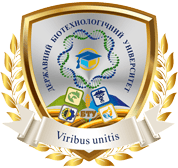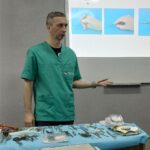About Faculty
Acting Dean – Candidate of Veterinary Sciences, Associate Professor Olesya Tsymerman
Deputy Deans:
- Candidate of veterinary sciences, associate professor Vikulina Galina – Deputy Dean for Educational and Scientific Work
- Сandidate of veterinary sciences, associate professor Sinyagovska Kateryna – Deputy Dean for Educational and Scientific Work
- Candidate of Agricultural Sciences, associate professor Shchepetilnikov Yury – Deputy Dean for for Disciplinary Work
Departments:
- Internal animal diseases and clinical diagnosis – head of the department, candidate of veterinary sciences, associate professor Matsenko Olena Viktorivna
- Veterinary surgery and reproductive medicine – head of the department, doctor of veterinary sciences, professor Dmytro Viktorovych Slyusarenko
- Epizootology and microbiology – head of the department, candidate of veterinary sciences, associate professor Severyn Raisa Vasylivna
- Normal and pathological morphology – head of the department, candidate of veterinary sciences, associate professor Olena Viktorivna Birka
- Pharmacology and parasitology – head of the department, candidate of veterinary sciences, associate professor Olga Vasylivna Nikiforova
- Veterinary sanitation, hygiene and veterinary law – head of the department, doctor of legal sciences, associate professor Olena Volodymyrivna Pavlichenko
- Physiology and biochemistry of animals – head of the department, candidate of biological sciences, associate professor Olga Mykolaivna Denisova
The Faculty of Veterinary Medicine of the State University of Biotechnology is one of the oldest faculties of veterinary medicine in Ukraine. The history of the faculty begins in 1851, which at that time was part of the Kharkiv Veterinary School. Currently, it is one of the leading faculties that trains highly qualified doctors of veterinary medicine.
About 90 scientific and pedagogical workers (2 of them academicians, corresponding members of the National Academy of Sciences of Ukraine, 12 doctors of sciences, professors, 65 candidates of sciences, associate professors, etc.) carry out educational and scientific work at the faculty. Scientific and pedagogical workers involved in the implementation of the following educational programs: “Veterinary medicine”, “Veterinary and sanitary examination, quality and safety of livestock products”.
The training of doctors of veterinary medicine is carried out exclusively in the full-time form of education at the second educational and qualification level “master”. The faculty also has the opportunity to study at the third educational and scientific level “Doctor of Philosophy”. The faculty trains specialists on a budgetary and contractual basis. Admission is possible on the basis of complete general secondary education (term of study 5 years and 10 months), on the basis of the educational level “junior bachelor” (4 years and 10 months), on the basis of the educational levels “bachelor” and “specialist” in related specialties (1 year and 4 months), based on the first higher education (4 years and 10 months).
Currently, about 800 students study at the faculty, including about 50 foreign students (state and English language of instruction).
Students of the Faculty of Veterinary Medicine study disciplines of general and professional training, 25% of which are chosen independently within their own educational trajectory. Practical training of students is carried out within educational (within the educational institution) and industrial (outside the educational institution) practices. Guest lectures by leading specialists in the field of veterinary medicine are common practice.
Faculty graduates successfully work both within the country and abroad (USA, Canada, Germany, Poland, Israel, Morocco and other countries).
Graduates who received the master’s degree have the right to work as chief doctors of veterinary medicine, heads of hospitals (clinics) or departments of veterinary medicine, doctors of veterinary medicine at meat and milk processing enterprises, in clinics, in particular for a narrow specialization – orthopedist, surgeon , ophthalmologist, exotologist, reproductive specialist, etc., at agricultural enterprises (farms, complexes, poultry farms, etc.), at pharmaceutical enterprises and in veterinary pharmacies, in laboratories of various forms of ownership, to open their own veterinary business, to be scientific employees in educational and scientific institutions, etc.
The faculty prepares students for the master’s level on the basis of complete general secondary education (term of study 5 years and 10 months), on the basis of the degree “junior bachelor” (term of study 4 years and 10 months), on the basis of the first higher education (term of study 4 years and 10 months) and on the basis of the degree “bachelor or specialist” (term of study 1 year and 4 months).
| Code | Components of educational program | Credits ECTS | Final control form |
|---|---|---|---|
| ОК1 | Ukrainian language for professional direction
working programe of educational component |
depends on a year of education | credit |
| ОК2 | Foreign language in professional activity
working programe of educational component |
depends on a year of education | exam |
| ОК3 | Latin (veterinary terminology)
working programe of educational component |
3 | credit |
| ОК4 | Philosophy
working programe of educational component |
depends on a year of education | credit |
| ОК5 | History of Ukrainian statehood and civil society
working programe of educational component |
depends on a year of education | credit |
| ОК6 | Anatomy of domestic animals (with educational practice) | depends on a year of education | exam, credit |
| ОК7 | Biochemistry of animals
working programe of educational component |
depends on a year of education | exam |
| ОК8 | Cytology, histology, embryology (with educational practice) | depends on a year of education | exam, credit |
| ОК9 | Bioorganic chemistry
working programe of educational component |
depends on a year of education | exam |
| ОК10 | Physiology of animals | depends on a year of education | exam |
| ОК11 | Life safety and labor protection in veterinary medicine
working programe of educational component |
depends on a year of education | credit |
| ОК12 | Veterinary jurisprudence of Ukraine and international veterinary legislation
working programe of educational component |
depends on a year of education | credit |
| ОК13 | Veterinary hygiene, sanitation and animal welfare
working programe of educational component |
depends on a year of education | exam |
| ОК14 | Veterinary microbiology (with educational practice)
working programe of educational component |
depends on a year of education | exam, credit |
| ОК15 | Veterinary immunology | depends on a year of education | credit |
| ОК16 | Veterinary virology (with educational practice) | depends on a year of education | exam, credit |
| ОК17 | Pathological physiology | depends on a year of education | exam |
| ОК18 | Obstetrics, gynaecology and biotechnology of animal reproduction (with educational practice)
working programe of educational component |
depends on a year of education | exam, course work, credit |
| ОК19 | Hygiene and examination of food products (with educational practice)
working programe of educational component |
depends on a year of education | exam, course work, credit |
| ОК20 | Epizootology and infectious diseases of animals (with educational practice)
working programe of educational component |
depends on a year of education | exam, course work, credit |
| ОК21 | General and special surgery (with educational practice) | depends on a year of education | exam, course work, credit |
| ОК22 | Operative surgery with the basics of topographical anatomy and anaesthesiology (with educational practice) | depends on a year of education | exam, credit |
| ОК23 | Veterinary parasitology (with educational practice) | depends on a year of education | exam, course work, credit |
| ОК24 | Pathological anatomy and dissection (with educational practice)
working programe of educational component |
depends on a year of education | exam, course work, credit |
| ОК25 | Internal diseases of animals (with educational practice)
working programe of educational component |
depends on a year of education | exam, course work, credit |
| ОК26 | Veterinary pharmacology
working programe of educational component |
depends on a year of education | credit |
| ОК27 | Veterinary clinical biochemistry | depends on a year of education | credit |
| ОК28 | Clinical diagnosis of animal diseases (with educational practice) | depends on a year of education | exam, course work, credit |
| ОК29 | Forensic veterinary medicine
working programe of educational component |
depends on a year of education | credit |
| ОК30 | Organization of biological research
working programe of educational component |
depends on a year of education | credit |
| ОК31 | Organization of veterinary affairs
working programe of educational component |
depends on a year of education | credit |
| ОК32 | Bioethics and professional ethics in veterinary medicine
working programe of educational component |
depends on a year of education | credit |
| ОК33 | Veterinary toxicology
working programe of educational component |
depends on a year of education | credit |
| Other types of training | |||
| ОК34 | Educational practice (introduction to the specialty) | 1 | credit |
| ОК35 | Production practice | 23 | defence |
| Final certification (option 1) | |||
| ОК36 | Preparation and compilation of USQE | 2 | exam |
| ОК37 | Preparation and defence of qualification work | 5 | defence |
| Final certification (option 2) | |||
| ОК36 | Preparation and compilation of USQE | 2 | exam |
| ОК37 | Preparation and passing of the clinical qualification exam | 5 | defence |
| The total volume of mandatory components – 270 (75%) | |||
| Code | Components of educational program | Credits ECTS | Final control form |
|---|---|---|---|
| 1 | Anatomy of a rabbit | 3 | credit |
| 2 | Safety and quality of food products
working programe of educational component |
3 | credit |
| 3 | Biochemical research methods in veterinary medicine
working programe of educational component |
3 | credit |
| 4 | Vaccinology in veterinary medicine
working programe of educational component |
3 | credit |
| 5 | Veterinary dermatology | 3 | credit |
| 6 | Veterinary dietetics taking into account anatomical and physiological features of small animals
working programe of educational component |
3 | credit |
| 7 | Veterinary endocrinology
working programe of educational component |
3 | credit |
| 8 | Veterinary mycology
working programe of educational component |
3 | credit |
| 9 | Veterinary cytopathology
working programe of educational component |
3 | credit |
| 10 | Veterinary preventive measures for emergent zoonoses
working programe of educational component |
3 | credit |
| 11 | Poisons and impact on a body
working programe of educational component |
3 | credit |
| 12 | Pharmacy business with the basics of manufactoring veterinary drugs
working programe of educational component |
3 | credit |
| 13 | Veterinary reproductology
working programe of educational component |
3 | credit |
| 14 | Species obstetrics, gynaecology and biotechnology of animal reproduction
working programe of educational component |
3 | credit |
| 15 | Features of non-infectious, invasive and infectious diseases of small animals
working programe of educational component |
3 | credit |
| 16 | Visual diagnostics in veterinary medicine
working programe of educational component |
3 | credit |
| 17 | Hygiene of feed and feed additives for productive and non-productive animals
working programe of educational component |
3 | credit |
| 18 | Hygiene of meat and meat products
working programe of educational component |
3 | credit |
| 19 | Hygiene of raw milk and drinking milk
working programe of educational component |
3 | credit |
| 20 | Hygiene of small pets
working programe of educational component |
3 | credit |
| 21 | Hygiene of egg products and food hydrobionts
working programe of educational component |
3 | credit |
| 22 | Histological technique and methods of morphological research
working programe of educational component |
3 | credit |
| 23 | Global parasitology
working programe of educational component |
3 | credit |
| 24 | Domestic, decorative and exotic birds, features of origin and use
working programe of educational component |
3 | credit |
| 25 | Ensuring the health of highly productive cows | 3 | credit |
| 26 | General pharmacognosy
working programe of educational component |
3 | credit |
| 27 | Zoopsychology with the basics of ethology
working programe of educational component |
3 | credit |
| 28 | Immunopatology in veterinary medicine
working programe of educational component |
3 | credit |
| 29 | Intellectual property in veterinary medicine
working programe of educational component |
3 | credit |
| 30 | Infectious diseases of animals of tropical and subtropical regions
working programe of educational component |
3 | credit |
| 31 | History of veterinary medicine
working programe of educational component |
3 | credit |
| 32 | Clinical veterinary andrology
working programe of educational component |
3 | credit |
| 33 | Clinical veterinary pharmacology and pharmacy
working programe of educational component |
3 | credit |
| 34 | Clinical pathophysiology
working programe of educational component |
3 | credit |
| 35 | Comprehensive diagnosis of infectious diseases of aquaculture
working programe of educational component |
3 | credit |
| 36 | Cryoveterinary
working programe of educational component |
3 | credit |
| 37 | Medicinal plants in veterinary medicine
working programe of educational component |
3 | credit |
| 38 | Methods of laboratory clinical diagnosis of animal diseases | 3 | credit |
| 39 | Fundamentals of management of veterinary medicine enterprises
working programe of educational component |
3 | credit |
| 40 | Peculiarities of surgical diseases of small animals
working programe of educational component |
3 | credit |
| 41 | Parasitic diseases of decorative and exotic birds
working programe of educational component |
3 | credit |
| 42 | Parasitic diseases of fish, bees and fur animals
working programe of educational component |
3 | credit |
| 43 | Legal regulation of animal welfare
working programe of educational component |
3 | credit |
| 44 | Reproduction of small animals
working programe of educational component |
3 | credit |
| 45 | Pig reproduction
working programe of educational component |
3 | credit |
| 46 | Pecularities of reproduction of small animals
working programe of educational component |
3 | credit |
| 47 | Parasitic diseases of exotic animals
working programe of educational component |
3 | credit |
| 48 | Spermatology
working programe of educational component |
3 | credit |
| 49 | Special research methods for surgical diseases of animals
working programe of educational component |
3 | credit |
| 50 | Modern laboratory diagnostics of cross-border animal diseases
working programe of educational component |
3 | credit |
| 51 | Modern standards of dog and cat breeds and directions of their selection
working programe of educational component |
3 | credit |
| 52 | Labour law in veterinary medicine
working programe of educational component |
3 | credit |
| 53 | Physiology and pathology of the mammary gland in animals
working programe of educational component |
3 | credit |
| 54 | Diseases of the maxillofacial apparatus in animals
working programe of educational component |
3 | credit |
| 55 | Chemistry around us
working programe of educational component |
3 | credit |
|
56
57
58
|
Aquachemistry
working programe of educational component Biodiversity conservation and chemicals in the EU working programe of educational component Ethology and physiology of birds working programe of educational component |
3
3
3
|
credit
credit
credit
|
| The total amount of sample components 174 credits ECTS, of which 90 credits ECTS (25.0%) must be selected, in particular from the general university catalogue | |||




